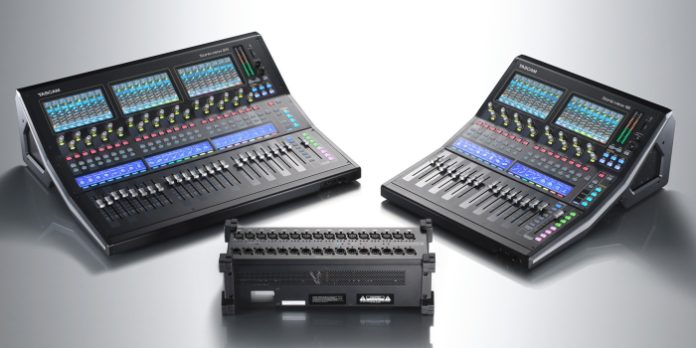What is the idea behind the introduction of the Sonicview range to the market?
“Tascam was an early creator of digital mixing consoles in the mid 1990s and developed a reputation alongside market leader Yamaha through 2000 to 2007. Unfortunately, the device that was used for the core audio processing in DM-24 and DM-4800 went EoL (End of Life) around 2012, and as it was so different to other DSP devices commonly used in digital mixers, it needed a complete restart in R&D, which then major shareholders refused to back. This meant that Tascam was effectively out of the digital mixer market for a decade.
“When a major shareholder sold its stake in TEAC Corporation, the company was then able to contemplate a return to the digital mixer market, although previous mixers had been primarily aimed at the studio/recording market. With some penetration in broadcast, the idea behind the Sonicview range was to make a mixer that was aimed at live events and broadcast, but still could be used in a studio/recording application.
“This meant we would need an audio networking capability (64×64 Dante is built-in), remote I/O, we have the SB-16D stagebox with 16 mic/line inputs and 16 line outputs with remote control of preamps, plus functionality for remote operation of the console (via our Sonicview Control App).
“Other features such as ultra-low latency for digital I/O (two samples @ 96kHz) and analogue I/O (0.51mS) were also key targets for the live sound market where in-ear monitoring needs as low delay as possible. One further target was to have extremely high headroom for the inputs, that can handle up to +32dBU without clipping, which provides immunity to spikes that can cause distortion or can even actually make preamps shut down for several seconds.
“Another driver was the overall visibility, flexibility and workflow that would support live events applications, and this is where the design with multiple screens and user configurability was focused for VIEW. Also, the internal architecture used is at the forefront of modern audio processing design, which gives us great flexibility, and with 54-bit floating point processing at 96kHz, amazing internal headroom, and incredible latency performance. Our target was to have a small footprint mixing console that would be applicable to smaller live venues, OB vans and live studios in broadcast.
“As a company involved in recording for 50 years, one further point that we could exploit was to offer a recording facility with the IF-MTR32 option card that not only could provide for 32-track live recording and playback (with virtual soundcheck etc.), but could also be used for flexible playback of atmospheres and backing tracks, and could also be used as a recording studio type recorder with tracking and overdubbing.
“The 32 in/out USB audio interface functionality offers use with any DAW and with virtual VST effects racks. As we had an existing range of Tascam format option cards with MADI or AES/EBU I/O, analogue outputs and if needed even more Dante I/O, it made sense to keep this option slot format for Sonicview.”
How does SV24, SV16 and SB-16D fit into the Sonicview family?
“Sonicview24 and Sonicview16 are identical for their internal mixing/processing capabilities and only differ in the size, number of screens, mic/line inputs and channel faders – Sonicview 16 has two touchscreens, 16 mic/line inputs and 16 channel faders, whereas Sonicview24 has three touchscreens, 24 mic/line inputs and 24 channel faders. Sonicview 16 also has 19in rack mounting capability.
“Our existing range of smaller Dante Compact Processors (DCP) as part of the Tascam overall offering for live sound together with Sonicview 16/24, complement the larger SB-16D stagebox unit which has 16 mic/line I/O. The DCP range provides a more distributed way to connect smaller groups of I/O on a stage rather than having to run multiple mic or line cables all to one location across the stage.
“These units each provide up to four input or output channels from the Dante network, for four mic/line inputs (MM-4D/IN), or four line outs (ML-4D/OUT)or stereo mic/line in/out (MM-2D) and they can be Powered over Ethernet (PoE), with remote control over the network via the DCP Connect App. Used with a PoE capable network switch at the side of the stage, it then just needs an Ethernet cable to each DCP unit, to connect inputs for say, the backing vocalists, keyboards rig, etcetra, and they can also be daisy chained.”
Which features will end users benefit from?
“Overall visibility of the channels, with flexible channel routing onto any of the custom fader layers. Access to any parameter with a single touch, ability to either spread a channel strip across two or three screens or to work with different functions from different channels simultaneously on more than one screen, metering, sending overviews, effects, and more. The Sonicview Control App can be used to show any function such as meters or other overviews on several external screens as well.”
What has the response been like?
“While we had shown Sonicview under the radar in late 2022 to several of our distributors and resellers, the press releases we issued ahead of ISE 2023 had a major impact on the number of people coming to the Tascam booth to look at and get some hands-on experience with Sonicview. The feedback we received was really great and we are all excited by the initial reaction from the market.”






